Introduction:
前言:
Chinese New Year is probably the only time of the year when you can play mahjong without being accused of engaging in illegal gambling. But while happy Chinese people everywhere are having a good time and laughing joyfully as they play, foreigners are left scratching their heads, unable to understand this quintessential part of Chinese culture. Here's Mahjong 101 for those who feel left out and can't wait any longer to break the cultural barrier.
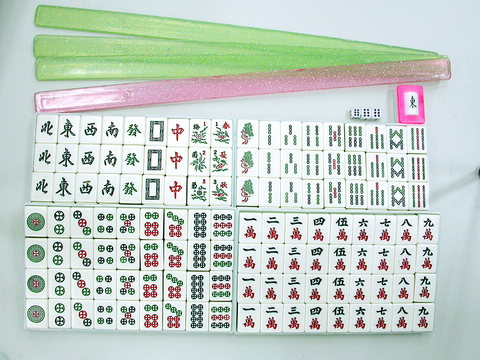
中國新年大概是一年中唯一可以合法打麻將的時候,不過當喜氣洋洋的中國人愉快地打著麻將,輕快的摸牌聲伴隨著笑聲響徹雲霄,外國人卻丈二金剛摸不著頭緒,無法了解這項中國國粹。Taipie Times特別規劃「麻將自救手冊」給覺得自己被冷落,或是等不及想打破文化藩籬的你。
The origins of mahjong:
麻將的起源
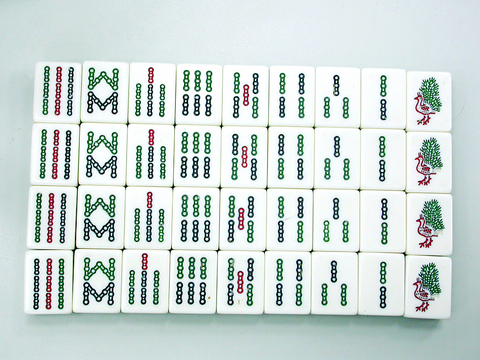
There are several theories about the origins of mahjong, but the most plausible one suggests Confucius developed the game around 500BC; the appearance of mahjong coincides with Confucius' travels, and the three main tiles correspond to his three basic doctrines: prosperity, benevolence and sincerity. All right, enough dry theory, we know you're chomping at the bit to play.
關於麻將的起源有幾個不同的理論,但是比較可信的說法是孔子在西元五百年前發明了麻將,因為麻將的圖字呼應他周遊列國的經歷及三大教條:昌盛、仁愛、意誠。好了,枯燥的理論說太多,你大概磨拳擦掌,躍躍欲試了吧。
Where can I buy a Mahjong set?
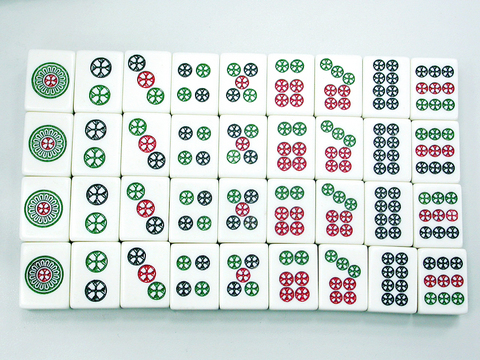
哪裡可以買到麻將?
A basic plastic set costs about NT$900. You can find one at major retailers and nightmarkets.
一副簡單的麻將約要新台幣九百元左右,各大賣場或夜市都買得到。
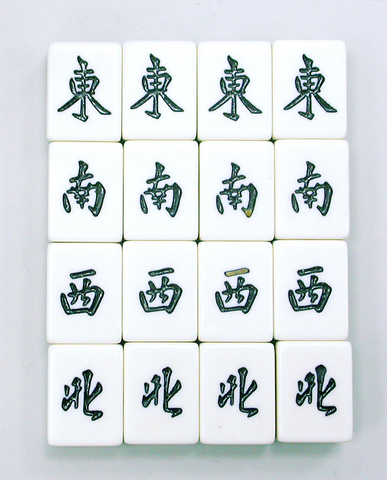
Suits of the tiles:
牌型介紹:
There are several kinds of mahjong. The mahjong we'll focus on is Taiwanese mahjong, which uses 144 tiles: 108 suit tiles, 28 honor tiles and 8 bonus tiles.
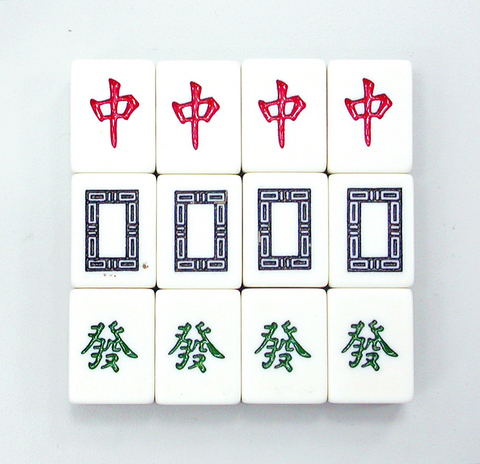
麻將有幾種形式,我們這裡談的是有一百四十四張牌的台灣麻將:其中有一百零八張同花色牌組、二十八張字牌和八張花牌。
1. There are three kinds of suit tiles, one kind showing a line, another a dot, and another a character. In Chinese we call them 索 (suo3), 筒 (tong3), and 萬 (wan4) respectively.
1.同花色牌組有筒字牌、索字牌和萬字牌。
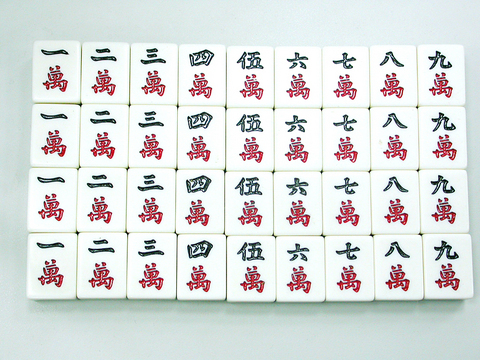
Note: Yes, that's right, the first "suo" tile looks like a bird. That's why we sometimes call this tile "yi1 zhi1" (一隻).
註:是的,第一張索看起來像一隻鳥,所以我們有時叫它「一隻」。
2. The honor tiles consist of dragon tiles and wind tiles. Dragon tiles come in three different colors and wind tiles come in four different directions.
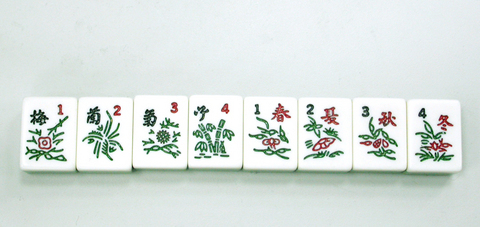
2.字牌包括三色的三元牌和有四種風向的四喜牌。
Here's how they look:
牌型如下:
The dragon tiles are called red 紅中 (hong2 zhong1)、white 白板 (bai2 ban3) and green 青發 (qing1 fa1).
The wind tiles are East 東 (dong1), South 南 (nan2), West 西 (xi1), and North 北 (bei3).
3. Lastly, bonus tiles 花牌 (hua1 pai2) are as follows.
3.最後花牌牌型如下:
The tiles mean: plum, orchid, bamboo, chrysanthemum, spring, summer, fall and winter. In Chinese they are written 梅 (mei2), 蘭 (lan2), 竹 (xhu2), 菊 (ju2), 春 (chun1), 夏 (xia4), 秋 (qiu1), 冬 (dong1) respectively.
Building the wall:
如何堆牌:
1. You need four people to play the game, and it's best to have a square table instead of a round one.
1.這個遊戲一共需要四個人,而且最好找一張四方桌,不要圓桌。
2. Take out one of each kind of wind tile and flip them over. Each player chooses one tile to decide where he will sit. For example, whoever picks up the North wind tile should sit to the North. Players should determine where each direction is located on the table before picking tiles.
2.拿出東南西北四喜牌,蓋起來,每個人抽一張,抽到北風就坐北位,不過玩家要事先決定桌子的風位。
3. Mix up all the tiles thoroughly and put them on the table facing down.
3.把牌蓋起來徹底搓乾淨。
4. Each player randomly selects 36 tiles to make a wall in front of him consisting of two horizontalrows of 18 face down tiles. Use the rack that comes with the Mahjong set to push the wall forward a little bit to make it nice and orderly. When each player has done this, the wall is complete.
Note: The pieces in the wall do not belong to anyone.
4.每個玩家隨意取三十六張牌在他桌前堆一道兩層各十八張的牌牆,並且用麻將組附贈的牌尺向前推並且排整齊。如此牌牆便完成了。
註:現在牌牆的排還不屬於任何人
How do you deal?
如何砌牌
1. In the first round, decide who will be the dealer by rolling three dice. For example, if the dice show a total of 13, count around the table counter-clockwise from the East, counting each player as one. Since the 13th direction lands on East, East is the dealer for the first round. If East wins the first round, he remains the dealer, but if he loses, North becomes the dealer. The person to the right of the dealer becomes the new dealer each time the dealer loses.
1.第一盤以丟三顆骰子決定誰是莊家,例如,如果三顆骰子一共十三點,從東家逆時針方向開始數十三,十三到東,東就是第一盤的莊家,贏了連莊,輸了逆時針方向換手。
2. Players now build up a bank of their own pieces by taking pieces from the wall. East throws the three dice to decide which part of the wall players will take pieces from first. If East rolls a 12, then count 12 counter-clockwise around the table. In this case South would be the 12th direction.
2.各家自砌好的牌牆取牌來堆自己的牆。此時東風擲三顆骰子來決定要從那一家的牌牆開始拿,若共十二點,從東風逆時針方向數十二,所以南風是十二,
3. As you face the south wall, count 12 pieces from the left.
3.面向南風牆牌,從左手方向數十二。
Note: Where you start taking pieces from on the South wall is also determined by East's roll of the dice.
註:這裡的十二即方才東家擲骰子決定的數目。
4. East begins by taking the 13th and 14th columns out of the south wall to make his own wall of 4 tiles. He begins with 13 and 14 because the roll of the dice was 12; South is the next position clockwise around the table, so South continues by taking the 15th and 16th columns out of the south wall; West takes the 17th and 18th columns out of the south wall; North continues clockwise around the table by taking the first and second columns out of the west wall; This continues until all the players have accumulated 16 tiles.
4. 現在東風從南風牆牌拿第十三、十四墩來堆自己的牆,他從第十三墩開始拿,因為剛才骰子的結果是十二;順時針方向的下一位是南風,所以他接著拿南風牆牌的十五、十六墩給自己蓋牆;西風再拿十七、十八墩,北風則順時針方向地取西風牆牌的第一、二墩,如此直到每位玩家都有十六張牌為止。
Organizing your tiles:
整理牌面:
1. Stand all your tiles facing toward you and put any bonus tiles out in front of your wall face up.
1.將所有的牌面向你,有花牌要拿出來放在牆外攤開。
2. Players now replace their bonus tiles with the tiles remaining in front of the South wall, which is called "gang4 wei3" (槓尾). In this case East returns to the 12th tile on the south wall and this time proceeds counter clockwise. Note that players can't randomly take tiles from the south wall; they must begin at the 12th and move consecutively towards the 1st.
2.逆時方向由莊家開始從槓尾(也就是南風前面剩下的十二墩牌)補牌,拿出多少花牌,就補多少牌,不能隨意抽取,必須從第十二墩開始朝第一墩拿,而且要一個接著一個。
3. Go counter-clockwise around the table to allow each player to replace his bonus tiles. Skip players who did not orginally draw any bonus tiles.
3.逆時針方向讓各家都作同樣的動作,不用補花的就跳過。

In an effort to fight phone scams, British mobile phone company O2 has introduced Daisy, an AI designed to engage phone con artists in time-wasting conversations. Daisy is portrayed as a kindly British granny, exploiting scammers’ tendency to target the elderly. Her voice, based on a real grandmother’s for authenticity, adds to her credibility in the role. “O2” has distributed several dedicated phone numbers online to direct scammers to Daisy instead of actual customers. When Daisy receives a call, she translates the scammers’ spoken words into text and then responds to them accordingly through a text-to-speech system. Remarkably, Daisy

Bilingual Story is a fictionalized account. 雙語故事部分內容純屬虛構。 Emma had reviewed 41 resumes that morning. While the ATS screened out 288 unqualified, she screened for AI slop. She could spot it a mile away. She muttered AI buzzwords like curses under her breath. “Team player.” “Results-driven.” “Stakeholder alignment.” “Leveraging core competencies.” Each resume reeked of AI modeling: a cemetery of cliches, tombstones of personality. AI wasn’t just changing hiring. It was draining the humanity from it. Then she found it: a plain PDF cover letter. No template. No design flourishes. The first line read: “I once tried to automate my

Every May 1, Hawaii comes alive with Lei Day, a festival celebrating the rich culture and spirit of the islands. Initiated in 1927 by the poet Don Blanding, Lei Day began as a tribute to the Hawaiian custom of making and wearing leis. The idea was quickly adopted and officially recognized as a holiday in 1929, and leis have since become a symbol of local pride and cultural preservation. In Hawaiian culture, leis are more than decorative garlands made from flowers, shells or feathers. For Hawaiians, giving a lei is as natural as saying “aloha.” It shows love and

1. 他走出門,左右看一下,就過了馬路。 ˇ He walked outside, looked left and right, and crossed the road. χ He walked outside and looked left and right, crossed the road. 註︰並列連接詞 and 在這句中連接三個述語。一般的結構是 x, y, and z。x and y and z 是加強語氣的結構,x and y, z 則不可以。 2. 他們知道自己的弱點以及如何趕上其他競爭者。 ˇ They saw where their weak points lay and how they could catch up with the other competitors. χ They saw where their weak points lay and how to catch up with the other competitors. 註:and 一般連接同等成分,結構相等的單詞、片語或子句。誤句中 and 的前面是子句,後面是不定詞片語,不能用 and 連接,必須把不定詞片語改為子句,and 前後的結構才相等。 3. 她坐上計程車,直接到機場。 ˇ She took a cab, which took her straight to the airport. ˇ She took a cab and it took her straight